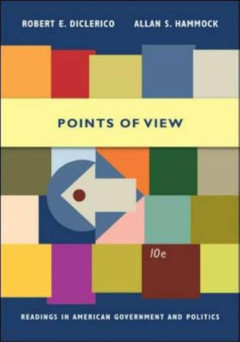Ditapis dengan

Point of View : Readings in American Government and Politics
- Edisi
- Ed.10.--
- ISBN/ISSN
- 978-0-07-310681-6
- Deskripsi Fisik
- xvi, 316p.; 23 cm.
- Judul Seri
- -
- No. Panggil
- 320.973 ROB p
- Edisi
- Ed.10.--
- ISBN/ISSN
- 978-0-07-310681-6
- Deskripsi Fisik
- xvi, 316p.; 23 cm.
- Judul Seri
- -
- No. Panggil
- 320.973 ROB p

Susan Dabaja is not keeping it civil. E-JOURNAL
The author criticizes Dearborn, Michigan Council President Susan Dabaja, who is running for 19th District Court judge, for her reaction to an editorial on the issue of her husband's federal conviction in a cigarette smuggling business. The author asserts that the publication has not only called out local officials who fall short of constituents's expectations, but also recognizes those who made…
- Edisi
- Vol. 32 Issue 1589
- ISBN/ISSN
- -
- Deskripsi Fisik
- -
- Judul Seri
- -
- No. Panggil
- -

Localism in Jordan Daily Press: Analytical Study of Daily Newspapers. E-JOURNAL
The aim of this study is to identify the characteristics of localism in Jordan daily press through analyzing the contents of four national daily newspapers. In so doing, the essay tried to find out how daily press is immersed in local affairs and the features of the press treatment of local affairs in order to find out the editorial policies adopted by press toward local affairs. This study sho…
- Edisi
- Vol. 6 Issue 3
- ISBN/ISSN
- 2071-9728
- Deskripsi Fisik
- -
- Judul Seri
- -
- No. Panggil
- -

Demonizing the tyrant: Saddam Hussein's image in Spanish news programs during…
This article analyzes Saddam Hussein's image as portrayed by the three leading Spanish television prime-time newscasts during the Iraq war, from 24 February to 1 May 2003. The television channels involved are the public broadcaster, TVE-1, and two commercial stations, Antena 3 and Telecinco. On one hand, the characteristics attributed to Saddam Hussein as a leader and his relationship with the …
- Edisi
- Vol. 3 Issue 1
- ISBN/ISSN
- 1751-2867
- Deskripsi Fisik
- -
- Judul Seri
- -
- No. Panggil
- -

New media and the Arab revolution: Citizen reporters and social activism. E-J…
The author discusses the role of new mass media in sustaining the momentum of the Arab revolution by broadcasting uncensored developments on the Internet. The popularity of political protests across the Middle East was marked by the development of satellite technology and growth of television channels such as Al-Jazeera, BBC Arabic, France 24 and Al-Hiwar. A new form of citizen journalism agais…
- Edisi
- Vol. 4 Issue 2/3
- ISBN/ISSN
- 1751-9411
- Deskripsi Fisik
- -
- Judul Seri
- -
- No. Panggil
- -

Normalization of War and Conflict in Iraq's Iraqiya Televison. E-JOURNAL
This article examines the practice of news journalists at Iraqiya, the Iraqi state broadcaster, in the context of the continuing conflict in Iraq. The paper draws on eighteen months of fieldwork at the channel's headquarters in Baghdad and on interviews with media practitioners throughout the news department. In this article, I show how Iraqiya news employees redefine media professionalism and …
- Edisi
- Vol. 10 Issue 2/3
- ISBN/ISSN
- 1873-9857
- Deskripsi Fisik
- -
- Judul Seri
- -
- No. Panggil
- -

On the Road to Democracy: Egyptian Bloggers and the Internet 2010. E-JOURNAL
In authoritarian-ruled Arab societies, new media, exemplified by the Internet, are perceived as the harbinger of democracy. In interviews conducted in Egypt in 2009, I asked bloggers, human rights activists and journalists about their motivations for blogging, the nature of the relationship between blogging and traditional media practitioners and the challenges that hinder the efficacy of blogg…
- Edisi
- Vol. 4 Issue 2/3
- ISBN/ISSN
- 1751-9411
- Deskripsi Fisik
- -
- Judul Seri
- -
- No. Panggil
- 306.2

Al-Kawakibi: From Political Journalism to a Political Science of the “Liber…
This article engages al-Kawakibi’s Taba’i‘ al-istibdad (The Characteristics of Oppression) as an instance of how Nahda writing dealt with the anxieties and ambivalence inherent in Ottoman Arab modernity. The Aleppine author was a political philosopher who universalized the Arab Muslim as a political subject. The article examines how al-Kawakibi defined “oppression” and “tyranny” a…
- Edisi
- Issue 37
- ISBN/ISSN
- 1110-8673
- Deskripsi Fisik
- -
- Judul Seri
- -
- No. Panggil
- 320

The Politics of Technology: On Bringing Social Theory into Technological Desi…
New approaches in the design of information technologies for work practices are drawing upon theories from sociology, anthropology, and social philosophy. Under the labels of Computer-Supported Cooperative Work (CSCW) and Participatory Design (PD), work is done to "return" to design insights gained in the social study of the use of technological artifacts. After a brief introduction of these …
- Edisi
- Vol. 23, Issue 4
- ISBN/ISSN
- 0162-2439
- Deskripsi Fisik
- 17Lembar
- Judul Seri
- -
- No. Panggil
- -

The Political Economy and Cultural Politics of Rural Nostalgia in Xi-Era Chin…
This article offers a new theoretical framework to understand nostalgia as a politicaleconomic and a cultural-political discourse in China. Introducing nostalgia as a “structure of feeling” in postreform China, the article analyzes its elevation as a new trope to address the economic and cultural contradictions of capitalistic global integration in the wake of the 2008 global financial c…
- Edisi
- Vol. 17
- ISBN/ISSN
- 1932-8036
- Deskripsi Fisik
- 4423–4442 hlm ; 20 lembar
- Judul Seri
- -
- No. Panggil
- -
 Karya Umum
Karya Umum  Filsafat
Filsafat  Agama
Agama  Ilmu-ilmu Sosial
Ilmu-ilmu Sosial  Bahasa
Bahasa  Ilmu-ilmu Murni
Ilmu-ilmu Murni  Ilmu-ilmu Terapan
Ilmu-ilmu Terapan  Kesenian, Hiburan, dan Olahraga
Kesenian, Hiburan, dan Olahraga  Kesusastraan
Kesusastraan  Geografi dan Sejarah
Geografi dan Sejarah